Chapter 8
“It’s a
classic West Virginia hunting or fishing camp: somebody put a trailer out and
before you know it, somebody put an addition on it. Before you know it somebody
put a deck on it and that’s about when we arrived.”—Al
Krueger
Outdoors:
Love of the
Wilderness
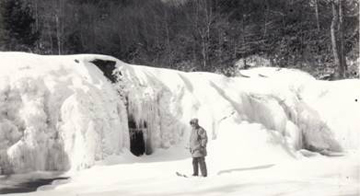 Camping
has always been a popular pastime on the Shavers Fork. The wilderness calls for
roughing it, leaving the comforts and confusion of civilization behind for a
while. Native Americans had few permanent settlements in the watershed but many
hunting camps. Doubtless even then the watershed was known as a wilderness.
While camping has become more popular since the ‘60s, there were plenty of
people with stories about camping back in the old days.
Camping
has always been a popular pastime on the Shavers Fork. The wilderness calls for
roughing it, leaving the comforts and confusion of civilization behind for a
while. Native Americans had few permanent settlements in the watershed but many
hunting camps. Doubtless even then the watershed was known as a wilderness.
While camping has become more popular since the ‘60s, there were plenty of
people with stories about camping back in the old days.
An adventurous Forest Service employee snowshoeing just below High Falls of
Cheat in January of 1948. Photo Courtesy Monongahela National Forest
Fluffo and Frozen Apples
Henry Nefflen has
a string of stories from his childhood in the 1950’s:
There was another time
that three of us went down, and we were going to trap. It was Jim Phillips, Bill
Boyles, and me. Back then we used to have a week off for Thanksgiving. At Nail
Run—that’s about halfway between here and Parsons—there’s an old schoolhouse
that a father of a friend owned. My parents insisted that I stay home for
Thanksgiving dinner, and my Mom sent in a pumpkin pie with me. When I went in it
was dark, and it started to snow, real big flakes.
My Dad brought us out.
One guy was already there, and I had traps, a gun, hip boots, clothing. It was
snowing like hell. Those SUVs weren’t all over the country back then either.
Hardly anyone had four-wheel drive. If someone wanted to go somewhere when it
was snowing they put chains on their wheels. A four-wheel drive vehicle was a
rarity. The power companies had them, and maybe the state had a couple. Dad had
a Pontiac station wagon, and he was worried about getting out of there.
Dad dropped us off, and
all the sudden we realized that all we had for that whole week was that pumpkin
pie I brought. Nobody else had brought any food. I was thinking that Jim had
food; he thought that we had food. Bill didn’t bring anything. And nobody was
coming after us for about a week. It snowed about two–three feet so there was no
way anybody was going to come after us.
We figured that we would set out
our traps and we would eat what we could catch. So we got all our traps set. We
set them down by the river. We thought we knew what we were doing but we were
novices and we didn’t really know what we were doing. The river came up—I mean
way up—and we lost all of our traps.
We didn’t have nothing.
We had a .22 and a handful of shells. We figured that if we shot a deer, no one
would get too mad at us if we took one out to keep us from starving to death.
But the snow was too deep for anything to stir. We did manage to kill one red
squirrel.
We found an old apple tree, and we
dug apples out of the snow. Those apples were rock hard. I mean rock hard. There
was a can of Fluffo. It was like Crisco but it was yellow. It was shortening. So
we had a can of Fluffo
and we found a box of pancake mix. So we had Fluffo,
pancakes, and apples because we ate that pie right away. So, for like four days
that was all we had to eat. Apples. Fried apples—we had to thaw them out—and we
would make apple pancakes. I remember spreading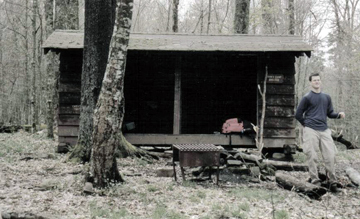 that Fluffo on the pancakes like
butter to make it taste better. I just about forgot about that trip . . . I was
probably sixteen years old. It was around 1960, forty-three years ago.
that Fluffo on the pancakes like
butter to make it taste better. I just about forgot about that trip . . . I was
probably sixteen years old. It was around 1960, forty-three years ago.
About the fourth or fifth day the
weather straightened up a bit and we found a house that wasn’t very far away. We
went up to the house and knocked on the door, and this kindly old woman came
out. We had some money between the three of us, and we offered to buy some milk,
because we figured milk and eggs would be the best thing in the world then. She
asked us why, and we explained everything to her. And she wouldn’t have none of
it. She took us in, and she fed us. I don’t know what it was, but boy, it was
one the best meals of my life. She insisted that we eat and she just poured the
food on.
John’s Camp Shelter: One of the shelters along
the Allegheny trail. Here the trail skirts the Back Allegheny Mountain near
Gaudineer Scenic area. Pictured is Justin Hargeshiemer a hiker from Alaska,
Justin says of the area, "This shelter was great, although
we ended up sleeping farther down the trail. It was located about four miles
from where we started, and at that point we just weren't ready to call it quits
for the day. There was a muddy sort of gully nearby, which made me think that
the shelter had originally been positioned in order to have a water source, but
it was mostly dry as we passed that day. It was plenty adequate for a lunch
break however..."
Photo courtesy Matthew Branch
Camping
on Little Black Fork
Henry continues:
Another time, Weese and
I went camping down here at Little Black Fork. It’s down here about four–five
miles. There are two streams down there, and they used to be real good trout
streams. They stocked them and there wasn’t near the pressure that there is now.
Like I said, you could drive up and down this river all day and not see another
soul. Went down on our bikes. We went way up there, and we camped.
Weese—he was a piece of
work—in high school he made the All American Team. He
was tenacious as hell,
but not very big so he
only got one scholarship out of it. He was an
animal but he was scared to death of bugs. We
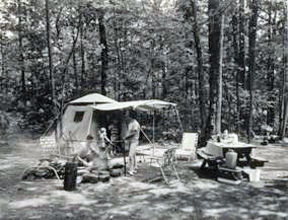 were
sitting there, and we had a campfire—a June bug landed on his toe—and he lost
it. We had a .22, and he starts shooting at the June bug. He starts shooting
everywhere. He shoots a hole in the frying pan—so he disables the frying pan—and
we were supposed to be up there about a week with no way of cooking anything.
were
sitting there, and we had a campfire—a June bug landed on his toe—and he lost
it. We had a .22, and he starts shooting at the June bug. He starts shooting
everywhere. He shoots a hole in the frying pan—so he disables the frying pan—and
we were supposed to be up there about a week with no way of cooking anything.
There still is a lot of empty
space up on the Shavers watershed. You could probably still spend a week up
there and not see another soul. We used to go up near Linan. There would be
three families of us, and we would make a big camp. We’d bring the kids and the
grandparents. And whoever had to work would go to work—that camp would be our
home for a while. People
still do it [camp out] some but
its not done as much as they used to. Now people have campers and whatnot. It’s
different now.
A campsite in the Monongahela National Forest,
1960’s. Photo courtesy Monongahela National Forest.
Walking
Off the Mountain
Boone Hall, who
operates a small campground in Bowden, has a story a lot more common among
campers today, especially those in the Bowden and Bemis area:
I originally started
camping up in Bear Haven. We just cleared off a spot and put a tent up. That was
‘57–‘58. Then we started camping at Stuarts Park. Then I cleared off a place
here and started camping.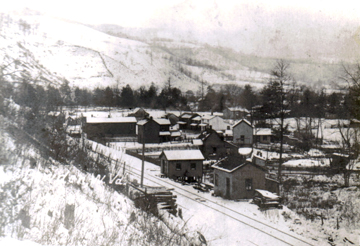 I hooked up the electric myself and did everything myself—well, me and my wife.
Now we’ve
probably got about twenty campers down there.
It’s just a bunch of friends. I retired a year and a half ago, and I’ve been up
here every week.
I hooked up the electric myself and did everything myself—well, me and my wife.
Now we’ve
probably got about twenty campers down there.
It’s just a bunch of friends. I retired a year and a half ago, and I’ve been up
here every week.
The first time I walked off the
mountain—I was about twenty years old—they told me it was an old Indian trail. I
walked down there, and it was rocks, cliffs, briars, brush. I never did find
that trail. I come down off that mountain, and a deer jumped—it scared me—I was
ready to shoot at anything. I was scared to death. You can’t get lost walking
off the mountain, but it takes about three hours to walk off the mountain.
That’s called Bickles Knob. Have you been up there yet? You should go up it. You
could do a lot up there. I can take you any time. We’ll go out . . . evening
when the sun goes down, it is the prettiest thing you have ever seen.
-
Bowden: An old photo of the
town of Bowden. Now much of it has changed, and is largely covered by
campgrounds.
Note the cleared pastures on the mountainside.
Photo courtesy Keith Metheny from his
grandfather, Clair Metheny.
Fireworks and Cavers
Chuck Hayhurst shares a
few humorous tales about his experiences camping, first at Alpine Shores, and
later at Revelle’s River Retreat, also in Bowden:
One night
up there—the 30th of May, Memorial Day—we always bought fireworks . . . No, it
was the 4th of July . . . We always bought fireworks. We had a friend from
Pittsburgh, and he always brought fireworks. We all pitched in and got some
fireworks. Every night at dark we put them things off. The people that have a
house about the campground there—Lorraine’s oldest son Tom, you’ve probably met
him—him and his two boys were up there on the porch. They were shooting
fireworks down at us, and we were shooting fireworks right back up at them. Kids
were pitching horseshoes. We had lights on down there, and we were having a big
time. And here come the state police, man and a woman, flying low!
The whole campground was
full of kids, and so the guys took off with the fireworks. One guy went this way
with the fireworks; another guy went the other way. So they came up and asked us
if we knew anything about it. We didn’t, and they started going around and
asking other folks if they knew anything about it. No one else knew anything
about it either.
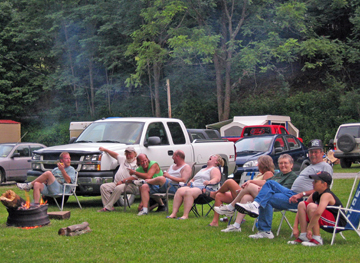 We
asked them, “How did you know that we was doing this?”
We
asked them, “How did you know that we was doing this?”
They said, “We was over
here, and we had stopped a car and was giving a citation.” But I knew that it
was somebody else had turned us in.
Anyway, they said, “If
we have to come back over here tonight, we’re gonna arrest each and every one of
you.”
We said, “What for?
We’re setting around a campfire drinking coffee.”
He said, “We’re gonna
get ya for drinking.”
I said, “How are you
gonna get anybody for drinking?”
I said, “Look it here:
everybody around here has a cup of coffee in their hand.”
And he hemmed and hawed
around that. He said, “We don’t know anything about that.” They had no sooner
left the driveway than Tommy started shooting fireworks at us, and we were
firing them back.
An evening around the
fire at Cheat River Campground, Faulkner.
Photo courtesy Shavers Fork Coalition.
Do
you remember when the spelunkers used to come up to Alpine Shores? They got a
bunch of spelunkers—that’s cave dwellers—they used to rent the whole campground,
and we were permanent up there. They had a big tent up right at the entrance. We
had to wear name plates before we could even get in our own campground. There
was doctors and lawyers, you name it. And they just let it all hang out. They
had the damnedest time you ever seen anybody have in your whole life. For a
whole weekend!
I got mad, and whenever
I couldn’t get to my camper because they had everything blocked off, I started
cutting ropes and everything else. There was a tent line going into my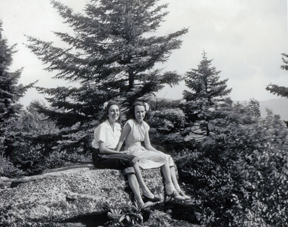 camper, and there was tents up in my yard. I went up and started raising hell
with the owner, Mrs. Burke.
camper, and there was tents up in my yard. I went up and started raising hell
with the owner, Mrs. Burke.
And she said, “No, No,
No, you gotta stay. You’ve never seen anything like this in your life!” Buddy,
we’ve NEVER seen anything like that in our lives!
This old boy here, he had this dog
. . . and, oh man, that dog . . . if he ate steak; the dog ate steak. One
morning he threw that dog some ham down in his plate on the ground. The dog just
cocked his leg and peed on it.
I said, “See what that
dog thinks of that damn ham? That dog wants steak. He don’t want ham!”
The cavers have since purchased
land for their annual gatherings but Chuck will always remember them.
Big Cat Tales
Stanley Woodell
wrote about his grandfather camping on top of Cheat Mountain sometime around the
turn of the twentieth century, before the railroad came in. What the wilderness
looked like then, we can only imagine:
My
granddad Amos Wooddell, Grant Higgins, Hanson Lindsay and my Dad were camping at
a small clearing about one half mile from what later was Old Spruce. They
cleaned their fish and threw the heads in the laurel by a spring. Just before
dark, Grant Higgins went to the spring for water and heard some animal growl.
The men lay down on some pine limbs to sleep. My Dad was next to the fire, and
Grant Higgins was on the outside.
After dark, Grant felt
something on his chest. He thought it was my Dad’s arm but when he felt warm air
in his face he opened his eyes to see a panther’s face. He screamed and rolled
across my Dad into the fire. They all jumped up and saw the long tailed panther
run into the woods. They built a big fire and sat around it the rest of the
night. The panther came back and sat on a log nearby and they could hear it
patting its tail on the log. They threw firewood at it but it
stayed until almost daylight and
it screamed as it went up the mountainside toward what is now called Bald Knob
[now part of Cass Scenic Railroad State Park].
While officially mountain lions
don’t exist in West Virginia, almost everyone had a story about seeing a big
cat. Perhaps the panthers have not yet heard that they are extinct.
Jean Wagener
recalls a hair-raising story:
My connection to Shavers
Fork began when I married Jerry Wagener in 1961. Jerry’s aunt, Mineta Anne
(Wagener) Auville, lived with her husband Raymond “Doc” Auville, below Two Lick
on the east side of the river from the late 40s until the late 50s. The
property is often referred to as “the old Auville place,” though their home has
been gone for many, many years.
But this was before our
cabin was built so this would have been probably ‘62. We were tent camping where
Jerry’s aunt’s house used to have been. Jerry’s brother was in a hammock up
above the road, en route to where our cabin is now. My parents were there and
Jerry and I. It was about 4:30 in the morning—it was early fall or late summer—I
heard the most horrible noise I have ever heard or ever want to hear in my life.
It was an absolutely blood-curdling scream—like a woman screaming.
I really did think that
if walked just a few feet to the riverbank we would see a woman chopped up into
a million pieces. We emerged—we were sleeping in the back of a station wagon,
and my Dad was coming out of the tent—the first thing that we thought of was
Jerry’s brother. Although we thought that the sound came from the river, we
worried about him sleeping up in the woods. He had slept through it. He hadn’t
even heard it.
We weren’t familiar with that blood-curdling
scream but we understand that with the mountain lion that occurs in either
mating or a kill. People know that. We didn’t see anything. It could have been
across the river but it was so loud! It makes my blood run cold just to talk
about it now. I never thought that there would be anything like that. It was
just terrible. In that same era, we found some pretty big prints that we thought
were cat prints. We took molds of them and brought them in. You never know.
Panther on Red Run
Jim White
tells the following story from not too long ago:
The only panther I ever knew or heard . . .
I’ve never heard a panther, I don’t think. My wife was in the hospital, and I
was working at the observatory. She had to have an operation. She was over in
the hospital. That must have been in 1968 or ‘69.
I was going over one
evening to see my wife. There is an area over on top of the mountain as you go
over Cheat Mountain from Durbin to Huttonsville. There is a run on top of the
mountain called Red Run. They call it that. It’s beyond Cheat Bridge. You can
see it there if you look for it. I tell you this before we get into the panther
tale.
The water that was up on
Cheat Mountain was like this: when that water got up, in any kind of a flood
stage, instead of turning muddy and milky like it did down here, it turned a
dark red. The superintendent here, they were having a debate over what was
turning the water red, so he wrote an article to the paper—I don’t know if it
was the one [newspaper] in Marlinton or the one in Charleston. But he came up
with the best explanation.
I guess the real reason
is that red spruce—the roots of it are real red—and that’s where it gets it name
from. The spruce tree isn’t red, and the timber isn’t red. The reason they call
it that is because of the roots. The roots—when you dig down to them, those
things have a red bark on them. So when the waters wash through those roots,
they turn the water red. That’s how Red Run got its name. If you look at that
run in the summertime when you can see it real good, or any time when there
isn’t snow on it or ice on it, you can see it real good. So, that’s how that got
its name.
Anyway, in that area
there is a big curve. There was a big gradual curve in the road—and that is
before you start to climb a little elevation to climb another mountaintop. You
are climbing two mountains: one on this side of Shavers Fork and one on the
other side. One is Back Allegheny and the other is either Cheat Mountain or
Shavers Mountain. But in that big curve—I was going there at night, it was a
while yet before dark—and something jumped in the road. At first I thought that
it was a huge dog. It was big. But it didn’t go across the road, it went and it
crouched just like a cat. It looked like a big cat. And then it jumped right
back into that wooded area. The two things that I remember about it is that it
jumped like a cat, just like a cat, and that it had a big long tail after it.
And it was the color of a panther.
Waterdogs,
Hellbenders
Not all animals on
Shavers Fork are as fearsome as panthers.
Henry Nefflen
describes one of the creatures that inhabits the watershed:
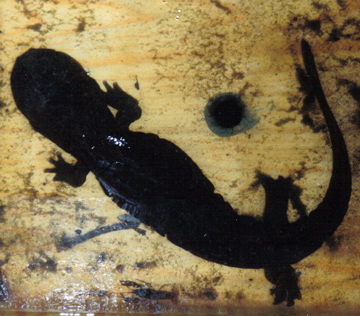 A
waterdog is an amphibian; it’s not a lizard. It looks like a baby alligator.
They get pretty long, like two feet. Someone caught one fishing the other day
and they kept them for a bit. They are all over the Appalachians. I’ve seen them
up to about twenty-eight inches long. Most folks that catch them kill them. I
used to too because I thought they killed fish, but they don’t.
A
waterdog is an amphibian; it’s not a lizard. It looks like a baby alligator.
They get pretty long, like two feet. Someone caught one fishing the other day
and they kept them for a bit. They are all over the Appalachians. I’ve seen them
up to about twenty-eight inches long. Most folks that catch them kill them. I
used to too because I thought they killed fish, but they don’t.
MudDog: Henry Nefflen says, “I’ve seen some that are
huge. Most of them are like this, and if you pick them up, it’s just like
picking up Jell-o. You see that crawdad? (bottom center) That wasn’t a little
crawdad, and that next to it is a full sized night-crawler. And like I said,
coons love ‘em, if you’re ever out along the river, particularly in the summer
and you come to a flat rock, and there’s a skull and a piece of backbone or
vertebra, that’s the remains of a waterdog. They’ll leave the head and the
backbone, that’s all you’ll ever find.”
Photo courtesy of
Henry Nefflen
A guy caught one, back
when we had the store, and he brought it in. We put it in a fish tank, and no
sooner had we gotten it, the DNR [Department of Natural Resources] came in like
three hours later, and they wanted us to turn it loose. He explained why and
gave us a lot of information. He said the one that we had, which was twenty-two,
twenty-three inches long and was about this big [diameter of soda can]. He said
that they live twenty-five–thirty years. They don’t know how long. They rarely
travel more than fifty feet from where they were born. They are just, if you
pick one up, it feels like you are picking up a lump of jelly.
They have lungs but the oxygen
exchange goes through their skin. ‘Coons love ‘em. The DNR guy typed a bunch of
it up, and we put some information up. We had people coming in for days on end
to look at that thing. I told the DNR guys that I wanted to show them to the
people. They thought it was a good idea, and they let us keep it for a bit.
After a while, we turned it back loose in the river. I’ve seen a bunch of them.
If you’re ever up the river, and you find a flat rock with a skull and a
backbone on it, that’s the remains of a waterdog. That’s all you’ll ever find.
Steve Lambert,
who grew up in Parsons, recalls these waterdogs, also called hellbenders:
Under
the town bridge in Parsons—that’s still part of Shavers Fork—I don’t know what
they are, the name or scientific name or anything about them, but us kids called
them waterdogs. They were great big lizards, about one and a half feet long.
You’d find them in the river hiding around the rocks. They would bite you, so we
would catch them by the tail and build a dam out of rock underneath the bridge
and keep them there. They’d eventually get out, I guess. I don’t hear kids talk
about them today. They wouldn’t make very good pets. They were ugly and would
latch on to you.
When I was a boy, we did spend an
awful lot of time on the river playing and jumping around. I lived with my great
grandmother in Parsons. If you went swimming, you’d better be dry before you
went home. She didn’t want me in the river. She never learned to swim herself
and was afraid I would drown. We did a lot of swimming but I have to tell you, I
made sure I was dry.
Bears
and Bark
Leo Weese tells a
strange story from the headwaters of the river:
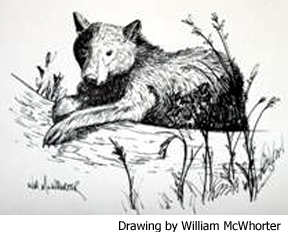 We
went up there one time—come around the bend from Slide Run [now on Snowshoe
property] in the head of the river—and then you go up a little ways and come
around the bend, and it opens up to a big basement. We came around a bend, and
the whole side of one hill was nothing but red. We got up there to see what in
the world it was. They had cut the timber, and little pine trees were growing
back in, but the pine logs were still lying there. Bear had torn that entire
side of the mountain there. I don’t know how many bears there were but they had
torn up the entire side of the mountain! They were eating the grubs inside the
bark. The whole side of that mountain was red! Shoot, there had to have been
ten, fifteen, twenty bears in order to tear up that whole thing.
We
went up there one time—come around the bend from Slide Run [now on Snowshoe
property] in the head of the river—and then you go up a little ways and come
around the bend, and it opens up to a big basement. We came around a bend, and
the whole side of one hill was nothing but red. We got up there to see what in
the world it was. They had cut the timber, and little pine trees were growing
back in, but the pine logs were still lying there. Bear had torn that entire
side of the mountain there. I don’t know how many bears there were but they had
torn up the entire side of the mountain! They were eating the grubs inside the
bark. The whole side of that mountain was red! Shoot, there had to have been
ten, fifteen, twenty bears in order to tear up that whole thing.
With the bear population on the
rise, more and more incidents involving bears occur.
Virgil Broughton
relates the following story:
I got bear-bit three
years ago up there. It was pure accident. I go up there [near the townsite of
Spruce] a lot by myself because I know that country. I was in a tent, and they
was real hungry. A big old bear and her cub smelled those rotten apples I’d put
out and came in under my tent. They feed out of those dumpsters at Snowshoe and
Silver Creek [ski resorts] so now they’re used to people. She came in, and I get
up trying to shoo her out because I don’t want her in there while I’m sleeping.
She got nasty about it. She don’t want to leave. I didn’t aim to kick her but I
kicked a little bit and got her in the side. And she turned and snapped and got
me in the calf of the leg. But as quick as she did that, she got the scent of
the blood, and boy she went through the tent. She left in a hurry, she and her
cub.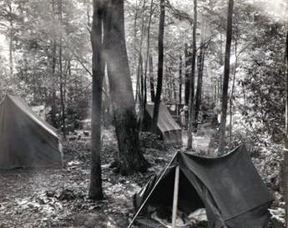
Jim Bazzle
recalls one instance where a bear showed up unexpectedly at his campground:
A while back we had a
bear cross the campground here. He came down off the mountain, crossed 33 and
the campground and went up the other mountain. That caused a commotion. There
was an elderly couple—I can’t remember their names but they were regulars—and
the wife said she heard a noise. The husband got up and saw a good-sized black
bear rummaging through their things.
He had a dry sense of
humor and said, “Oh, its nothing but a big black bear out there.”
She says, “Oh come on.”
And she opens the door and, of course, slams the door and screams. The bear got
scared and ran off. The stories that circulated from that were just great.
Tent camping
in the National Forest. Photo courtesy Monongahela National Forest.
Kayaking in Winter
Jim Snyder
wrote about one of his amazing journeys down the Shavers Fork in a kayak during
the wintertime. The trip takes two days and the camping seems extreme:
Iceman has claws a half inch long of pure crystalline water but he’s not really
dangerous. Slushpuppy’s paws are also armored in ice, on the outside at least.
He’s pretty harmless too. He’s been mesmerized by the “phhhht, phhht, phhhht”
sound of the endless slush balls that have been grazing past his hull for hours.
The slush appeared overnight. It was a very cold night. These two characters
have nearly returned to civilization.
The
first cabin they encounter has a young couple walking their dog in the brisk
sunny snow. “Did you camp overnight up there?” They can’t help but wonder.
“That’s pretty brave in this weather,” they concede.
Slushpuppy
mumbles that he read something about sunny beaches in the brochure. “That’s
after March first. You should have read the fine print,” he’s informed.
Still dazzled,
Slushpuppy admits, “It was beautiful anyway.” They slip back into the
persuasions of the current.
The crystal
clear water seemed to be calling them on. “Don’t mind the howling wind,” it
said. “Come ride through the beauty. You won’t have to say a word. Just witness
what is offered.” The howling wind was a factor but they didn’t mind. Their
inner warmth pounded out through their face as it had for the last twenty-four
hours. The searching wind sucked it away hungrily. No harm done. There’s more
where that came from.
The
wind first said hello in no uncertain terms at the highest put-in east of the
Black Hills of South Dakota—some 3,800 feet above sea level in the abandoned
logging town of Spruce, West Virginia, on the highest reach of the Shavers Fork
of the Cheat River. The wind owns this sunny spot in the woods now. It sweeps in
and cleans it regularly, looking for strange characters like Iceman and
Slushpuppy.
They presented
themselves to the elements by jumping from the Salamander, a sightseeing
excursion train, which conveniently supplied their entire shuttle. Their
vehicles would be waiting at the take-out tomorrow. About thirty senior citizens
were on the train: now peering from the windows as if watching a car wreck. They
were concerned but unable to voice any cautious tones. It was clear there was no
stopping these characters.
They pulled their boats off and slipped quietly away toward the diminutive
stream amidst swirls of glistening snow tornadoes. They were on their way, alone
together into the cold. The boats were maybe ninety pounds each and a bit
sluggish. But the river slid by, undemanding for the most part. A small rock
here; a leaning tree there. It was just enough to keep you busy.
In
no time at all, signs of Spruce were gone and all that remained was the gin
clear water and the curious wind working its way through a forest trying
to rediscover itself. Once a cathedral of towering spruce trees it was now a
recovering wilderness with a large deciduous population featuring spunky birch
trees as a predominant species.
There was occasional conversation, but Iceman and Slushpuppy would consistently
disappear, becoming only silent hulls blended with water and rocks. It had to be
cold. Their boats and hand coverings were shielded in ice within the first few
minutes of the trip. Temperatures around twenty and ten to fifteen mile per hour
winds will do that to you. Your boat, paddle, hands, skirt, and helmet all
acquire a sheen of pure ice. It’s exceedingly cool.
After a while it was time to search out a campsite so there would be time to
start dinner before dark. From his boat, Slushpuppy identified a flat area near
a hillside and in among the trees where the wind would have a harder time
finding them. He got out of his boat to check more closely and walked to the
actual spot. When he got there he could see the ground was really quite soggy
and wet—unusable. It had rained the day before, affording them the water to
travel on, but now the snow iced everything over. He went to call to Iceman to
tell him he might want to stay in his boat and save himself the trouble but it
was too late. He was already out of his boat and coming to see the situation for
himself.
After a few minutes of searching, it was clear there were no good spots at this
landing and they would have to proceed further down the river. But a problem had
developed. In the five minutes it had taken to check the site, their
spray-skirts had frozen solid. They wouldn’t go back on the boats to seal the
water out in this condition. Slushpuppy’s hands were bleeding from the tiny cuts
the ice was giving him. They would have to proceed without the skirts on.
There’s only so much water you can get in a ninety-pound kayak, before you start
to sink.
Fortunately, they found a fine site before the beginning of the next riffle—a
great flat site, which had been used before at the mouth of the sizable “Second
Fork” of the Shavers Fork. Without much ado, they started gathering firewood in
earnest. River creatures are pretty vulnerable when out of their shells.
Within a half hour the fire was crackling and they had a sense they could
survive. More firewood and more and more and more were stacked in a high heap
near the fire. The temperatures were plummeting and the wind and snow were
really kicking up. The air temperatures were dropping fast through the teens in
the last hour or so before dark. Fire established, they made short work of
setting up a shielding tarp and a couple tents.
Slushpuppy brought three sleeping bags because he is intimidated by the cold and
didn’t want to die a cool but stupid death. Dark came on and the cold dominated.
Slushpuppy went to get three cups of water from the river to make some nice
spicy Jambalaya with chicken for dinner. The first cup poured into the aluminum
pot froze solid. The two following rendered a pile of slush. Then Slushpuppy
found that his cooking stove had a problem with cold weather. Its poor frozen
pump gasket didn’t want to work, so onto the fire with the pot.
In about twenty
minutes (collecting firewood in the meanwhile), the food was hot and ready.
Spooned into bowls, it lasted almost five minutes before the last cold spoonfuls
disappeared. Iceman brought military MRE rations as a guaranteed food backup but
they soon froze solid. He kept his water bottles close to the fire because they
were freezing so fast.
Slushpuppy had
a tiny ice cube left in his water bottle so Iceman volunteered his thawed water
to the thirsty dog. The Pupster took a sip and then poured the rest into his
water bottle to melt his ice cube. Just that fast, the entire contents turned
into slush right before their eyes. Slushpuppy was thirsty still so he kept the
bottle close to the fire and drank the remainder as slush.
The
winds picked up to where they were howling through the treetops moaning, “Who
DARES come see? Who DARES to survive my glance?”
“I think its
bedtime,” Slushpuppy conceded at a ridiculously early hour. “I’m standing two
feet from a roaring fire and can’t feel its warmth”.
So
into the cocoons and after endless fussing, it was established they were both
“toasty warm” and guaranteed to survive the night. Within minutes Iceman was
answering the wind with peaceful snores. But Slushpuppy stayed awake for hours
for some undefined reason. Maybe he was waiting to see what would happen next?
Maybe the “phhht, phhht, phhhht” of snow piling on his tent kept
his attention.
After a while, Slushpuppy woke himself with his own snoring so he had proof that
he gotten at least some sleep. In the wee hours of the night the temperatures
slipped into the single digits with wind-chill well below zero.
Early, early in the morning, at first light, Slushpuppy ventured out to see if
the coals had frozen. The fire was way out but some coals remained. A serious
high pile of small sticks was assembled and the firewater from the
malfunctioning stove was sacrificed. Soon a “no foolin’ around” fire was
happening. The business of thawing the skirts got underway. Going to the river
for coffee water, Slushpuppy noticed things had changed. A large volume of slush
was now growing from the upstream side of rocks on the bottom of the stream. The
entire streambed of Second Fork was blanketed with the gentle structure and ice
was now encroaching from both shores in an effort to connect across the calmer
sections of current. But the winds had subsided and the temperatures were rising
over 10 degrees so a warm day seemed to be on tap.
Before long the entire camp structure had receded into the kayaks and the
characters pushed of into the slush ridden waters. “Phhht, phhht, phhhht” was
the chorus of every stroke and every bit of progress with the hull. Again they
disappeared in the silence.
Deciduous mountains spiked with snow-laden evergreens etched themselves in a
corner of their memories. They became one with a cold and indifferent world
where somehow they felt they belonged. Somehow it spoke to them, “Come back when
you can. We’ll wait for you here,” whispered the elements.
Summer Swimming Holes
Shavers Fork has its swimming
holes, of course.
Zach Henderson,
founder of the Shavers Fork Coalition, tells about how he first became enchanted
with the river:
My stories are about my
first trip to the swimming hole. You know, going out with a
couple kids from the eastern U.S. A lot of the kids at Davis and Elkins College
are from New Jersey and New York--you know,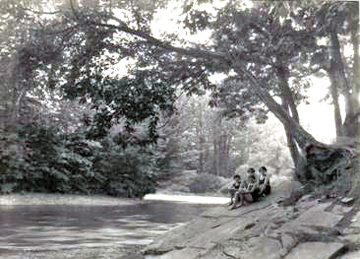 Manhattan, Long Island, Philly
suburbs--and had never experienced anything like that. I grew up on the beach,
and I knew water but I didn’t
know swimming holes.
Manhattan, Long Island, Philly
suburbs--and had never experienced anything like that. I grew up on the beach,
and I knew water but I didn’t
know swimming holes.
Swimming holes were a
whole new thing to me: going to a freshwater, deep
water spot. My first trip out there--I went with a couple kids from the eastern
shore of Maryland--and at that time they had a big platform set up in the trees.
You had to climb up to the platform and swing off the rope and you got
twenty–thirty feet of air and dropped down in that hole. There were roots coming
up the bank of the river. You had to rock climb, you know, no rocks but you had
to climb up the bank.
It was a really great
experience being out there in that freshwater stream. You travel anywhere in the
state, and that’s where people gather. It’s like the beaches of West Virginia.
You go out, and you’ll see twenty people in a swimming hole. There’s a nice
diving rock down by the fish hatchery. A lot of people go to that one, but we
try to avoid the ones with too many people.
Undated photo of four girls at a swimming hole
near Bowden. Photo courtesy Monongahela National Forest.
Swimming holes are unsupervised so
sometimes people run into trouble.
Mariwyn McClain Smith, also a Parsons’ native, recalls
a close call in the 1940’s:
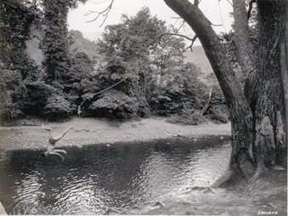 I remember when my mother and sister almost drowned in the Shavers Fork. Ed was
the oldest and me and then Rachel. Mom and Dad both liked to swim real well.
They would take us to Porterwood, behind the church there in Porterwood, and
swim in the river. I guess actually, Dad saved Ed one time in that area, but the
time I’m thinking about, Rachel got in a hole and couldn’t get out. Mom went in
after her, and Rachel stood on her shoulders.
I remember when my mother and sister almost drowned in the Shavers Fork. Ed was
the oldest and me and then Rachel. Mom and Dad both liked to swim real well.
They would take us to Porterwood, behind the church there in Porterwood, and
swim in the river. I guess actually, Dad saved Ed one time in that area, but the
time I’m thinking about, Rachel got in a hole and couldn’t get out. Mom went in
after her, and Rachel stood on her shoulders.
Mom was a Red Cross
lifeguard. She was a very good swimmer. Dad went in and got Mom, and a neighbor
grabbed Rachel by her pigtails and pulled her out of there. She was probably
eight or ten at the time.
We swam in the rivers
all the time. There weren’t any pools around here. And we would walk up in the
Pulp Mill Bottom to what we would call Peterson hole, which is actually still in
town—just in town—we went there frequently. We loved the river.
Rope Swing on Shavers Fork near Bowden.
Photo courtesy Monongahela National Forest.
These spots weren’t just
popular for the swimming.
Henry Nefflen
recalls his carefree high school days:
I remember when I was a little bit
older, back when you found some thrills in a beer bottle. I remember you could
come out on a weekend and all you had to do is stop—be the first one—someone
else would see ya and bring a cooler of beer. The next guy would have a guitar
or something and then someone else, and soon you’d have a party. It wouldn’t be
anything to have twenty–thirty people out at Faulkner Hole.
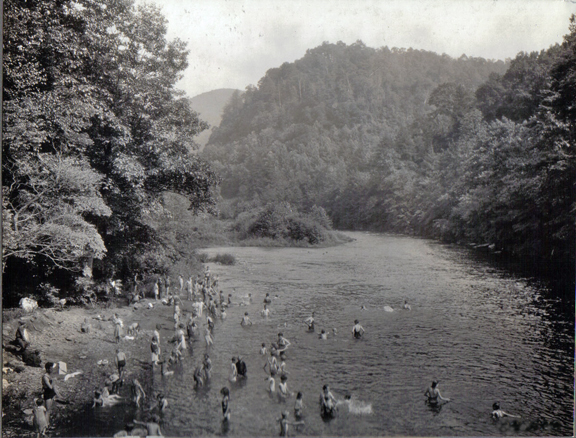
August 1935, Health Camp, Shavers Fork.
Photo courtesy Monongahela National Forest.
Link to
Chapter Nine
 Camping
has always been a popular pastime on the Shavers Fork. The wilderness calls for
roughing it, leaving the comforts and confusion of civilization behind for a
while. Native Americans had few permanent settlements in the watershed but many
hunting camps. Doubtless even then the watershed was known as a wilderness.
While camping has become more popular since the ‘60s, there were plenty of
people with stories about camping back in the old days.
Camping
has always been a popular pastime on the Shavers Fork. The wilderness calls for
roughing it, leaving the comforts and confusion of civilization behind for a
while. Native Americans had few permanent settlements in the watershed but many
hunting camps. Doubtless even then the watershed was known as a wilderness.
While camping has become more popular since the ‘60s, there were plenty of
people with stories about camping back in the old days. 


 We
asked them, “How did you know that we was doing this?”
We
asked them, “How did you know that we was doing this?”  camper, and there was tents up in my yard. I went up and started raising hell
with the owner, Mrs. Burke.
camper, and there was tents up in my yard. I went up and started raising hell
with the owner, Mrs. Burke. 



 I remember when my mother and sister almost drowned in the Shavers Fork. Ed was
the oldest and me and then Rachel. Mom and Dad both liked to swim real well.
They would take us to Porterwood, behind the church there in Porterwood, and
swim in the river. I guess actually, Dad saved Ed one time in that area, but the
time I’m thinking about, Rachel got in a hole and couldn’t get out. Mom went in
after her, and Rachel stood on her shoulders.
I remember when my mother and sister almost drowned in the Shavers Fork. Ed was
the oldest and me and then Rachel. Mom and Dad both liked to swim real well.
They would take us to Porterwood, behind the church there in Porterwood, and
swim in the river. I guess actually, Dad saved Ed one time in that area, but the
time I’m thinking about, Rachel got in a hole and couldn’t get out. Mom went in
after her, and Rachel stood on her shoulders. 